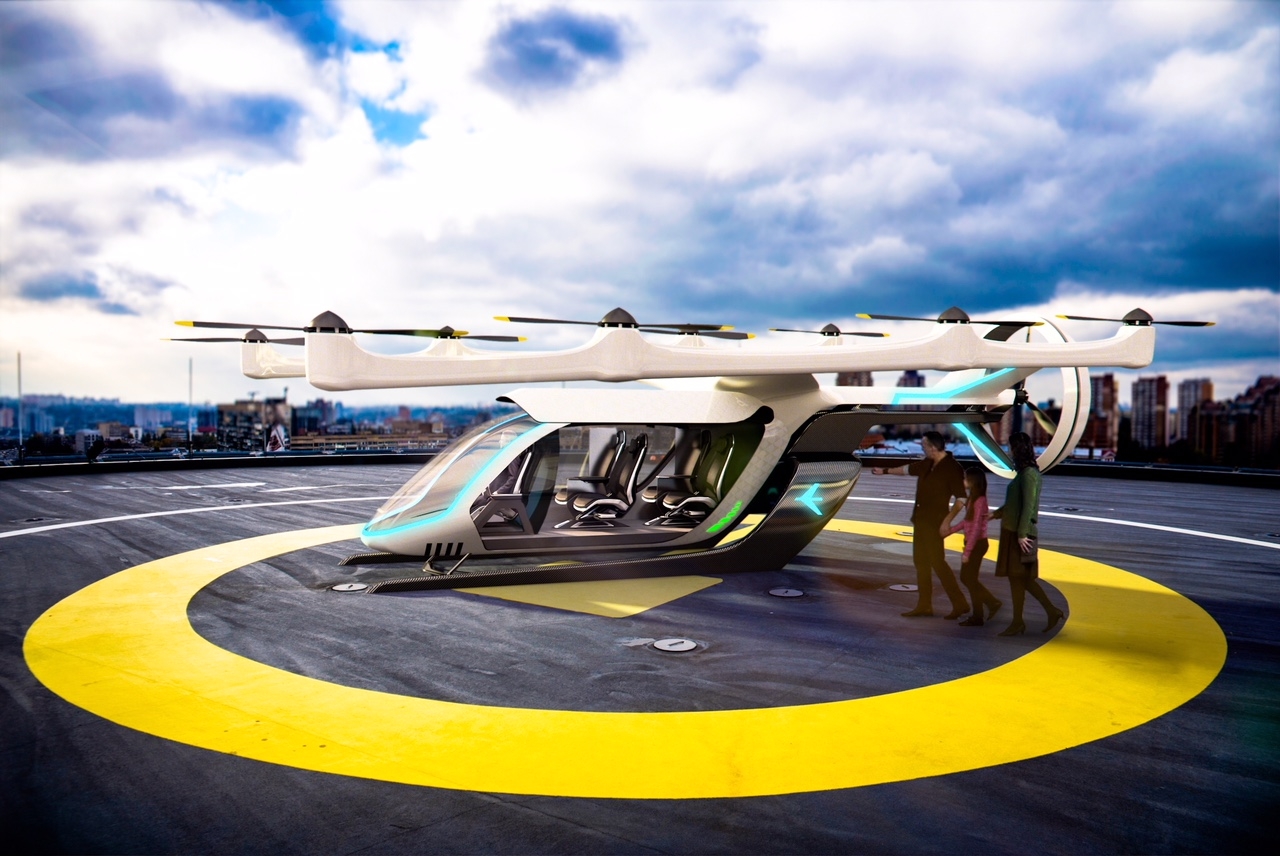 Embraer X公司最新推出的 eVTOL 城市移动概念机采用了一种清洁安静的电动推进系统,由多个螺旋桨和旋翼产生动力。目前,这款最新概念飞机已在今年 5 月举办的 2018 年 Uber Elevate 展会上亮相(图片来源:巴西航空工业公司)。
Embraer X公司最新推出的 eVTOL 城市移动概念机采用了一种清洁安静的电动推进系统,由多个螺旋桨和旋翼产生动力。目前,这款最新概念飞机已在今年 5 月举办的 2018 年 Uber Elevate 展会上亮相(图片来源:巴西航空工业公司)。
过去几十年中,“空中自动驾驶汽车”和“空中出租车”一直是科幻电影的常用元素,如今,这一切可能即将成为现实。Embraer现已宣布计划开发一种极具未来风格的小型商用飞行器。事实上,有意挺进空中移动出行市场的公司并不只有Embraer。多家公司均已开展空中飞行器项目,并且都声称自己的产品将在未来几年内颠覆人们的空中移动出行方式。
Embraer从设计开发涡轮螺旋桨运输机系列开始,发展至小型喷气式客机和公务机领域,并最终进入 140 座的双发喷气机市场,目前全球总销量达 8000 多台。Embraer的发展对巴西的飞机设计和制造能力的跃升做出了巨大贡献。
这些产品线取得了巨大的成功,并同时确立了Embraer作为一家全球领先航空航天企业的地位。然而,迄今为止,Embraer的产品仍属于传统设计,也就是选择全球顶级供应商的最佳新功能进行整合,不断将更高性能的节油引擎、集成式线控航空电子系统、玻璃驾驶舱融入自己的新设计中,并同时越来越多地采用复合材料零部件。
不过,这种情况即将成为历史。目前,Embraer旗下分公司 Embraer X (位于佛罗里达州墨尔本)已经宣布将推出一款有潜力改变行业面貌的全新电动垂直起降(eVTOL)概念机,昂首挺进颠覆性的空中移动出行市场。Embraer X 旨在研发高度创新、挑战极限、甚至有可能改变行业规则的航空飞行器,并在不久的将来推出真正可以进入市场的新产品。
目前,Embraer在美国硅谷和波士顿都有研发团队,专门负责与其他创新团队的沟通和合作。现阶段,Embraer X 的首要任务是与其他企业一起探讨以下图景的实现可能性——基于目前快速增长的VTOL无人机和电力推进技术,研发出一种与现有飞机截然不同的飞行器,并将其发展成为一种革命性但很实用的出行方案,以满足不断增长的、对更直接、更私人的高端城市交通方式的需求。
今年 5 月,Embraer X 公司在洛杉矶举办 2018 年 Uber Elevate 活动中发布了旗下具有革命意义的全新移动出行概念机的设计理念。
当时,Embraer 公司总裁兼 CEO Paulo Cesar de Souza e Silva 表示,“我们坚持不懈地追求持续增长,通过创立 Embraer X 公司,我们将推动颠覆性创新的到来,并加速拓展具有指数性增长潜力的新业务。城市移动出行转型条件已经成熟,而我们将尽全力在这个关键市场发挥关键作用。”
eVTOL 的最初设计将全部从安全性、乘客体验、价格成本、低噪声、小排放等最根本的关键驱动因素出发。
De Souza e Silva补充道,“我们正在开发一种‘按需提供’的城市空中移动出行解决方案,为数百万城市人口提升出行质量。通过与相关方面的共同努力,我们将努力加快实现这个全新的生态系统。”
如果我们与优步提出的Elevate 生态系统比较来看, eVTOL 项目反映了 Embraer X 公司抢占领先地位、迎接挑战与困难,并持续保持竞争力的决心,但同时,这也的确将为这家巴西飞机制造商带来严峻的技术挑战,研发难度远超现有飞机设计的水平。
首先,电力推进系统具有清洁、安静的特点,因此毫无疑问地成为了新飞行器的首选。从现有的配电设施和新材料的发展趋势来看,电力推进系统将成为行业最有可能采用的动力技术路线,而未来几年内系统本身的发展也会进一步巩固其地位。当今无人机采用的多倾斜螺旋桨或旋翼设计展现出了出色的控制水平和稳定性,有望成为新飞行器的标准架构。
然而,尽管这种无人机架构很容易拓展成为载客量相对较少的飞行器,但点到点飞行的续航时间依然难以保证。
尽管具有低噪声和小排放等优势,但几乎所有目前提出的VTOL飞行器设计的续航里程都大大低于同级别的传统轻型直升机。由于充电期间飞行器是无法产生收益的,因此停工时间是目前飞行器面临的一个重要问题。未来的空中出租制造商已经在研究多种解决方案,其中一种就是将乘客舱,或“负荷舱”转移至已经充好电的飞行器中。随着技术的进步电池重量将稳步下降,但对一辆轻型空中汽车而言,可能依然是一个较大的负担。
无论如何,只有经过计算机仿真、平台验证测试及最终的实际飞行评估后,飞机制造商才能真正了解这种日常 eVTOL飞行器的实现可能性,让我们拭目以待吧。
Autonomous flying cars and air-taxis have been the subject of science fiction movies for decades, but Brazilian aerospace manufacturer Embraer has now announced plans to develop a practical – if futuristic – small commercial air vehicle. However, Embraer is far from alone as a new generation of disruptive aerial projects emerge from new and established companies, all claiming they will change how we use air transport in the coming years.
There has been a huge leap in aircraft design and manufacturing capability in Brazil as Embraer gradually evolved families of regional turboprop transports and then expanded into small jet feeder- liners and business jets; until finally entering into the 140-seat twin jet market, with over 8,000 global sales in total.
These product lines have been highly successful and confirmed Embraer as a global aerospace player, but to date they have all been conventional in concept, taking the best new features from world-class suppliers, incorporating fuel-efficient engines, integrated avionics systems with fly-by-wire controls and glass cockpits, and increasing use of composite components.
But now the company’s new offshoot, Embraer X, based in Melbourne, Florida, has moved into the front-line of disruptive innovation with its announcement of a new electric-powered Vertical Take-Off and Landing (eVTOL) aircraft concept. This company has been created to develop highly innovative, potentially game-changing, aerospace projects taking technologies to the limit, and leading to new products in the not-too-distant future.
There are Embraer innovation teams in Silicon Valley, California, as well as in Boston, who are integrating and collaborating with other innovation communities. At this stage the company priority is to join with other enterprises to examine the realistic prospects for introducing a radically different air vehicle that takes today’s rapidly expanding VTOL drone and electric technology and up-scales it to provide a revolutionary, yet practical, solution for meeting the needs of growing, more sophisticated, communities who will need direct, and more personal, transport – especially in city environments.
Embraer X used the occasion of the Uber Elevate 2018 event in Los Angeles, in May, to unveil its outline aircraft design.
“We are relentless in our quest for constant growth and through Embraer X we will drive disruptive innovation and accelerate the creation of new businesses with the potential for exponential growth. Urban mobility is ripe for transformation and we are committed to having a major role in this key market,” said company president and CEO, Paulo Cesar de Souza e Silva.
The eVTOL initial design is built around what are described as key-drivers – safety, passenger experience, affordability and very low noise and emissions footprint for the community.
“We are developing solutions to bring on-demand air transportation to urban areas to improve quality of life for millions of people. Our collaboration with key stakeholders will accelerate the arrival of this new eco-system,” added de Souza e Silva.
Seen in the context of Uber’s Elevate ecosystem, the new Embraer X initiative demonstrates that the Brazilian-owned company intends to keeping ahead of the current immature demand curve, to maintain a competitive position when all the many associated challenges have been identified and overcome. Those challenges do represent some steep technological mountains yet to climb as they extend well beyond the development of air vehicles, which already pose difficult design issues.
To start, the choice of electric propulsion is an obvious decision, as it is clean and quiet. Power distribution and new materials make it the most predictable course for the industry and electric propulsion technologies will firm up in the coming years. Multiple tilt propellers or rotors have made the aircraft architecture seen in today’s drones an acceptable standard for further development, as they allow for good control and stability.
However, even though they are easily adapted to larger air platforms with the relatively light, urban use payloads, there are still shortcomings when it comes to point-to-point flight time endurance.
Almost all the projected VTOL designs that have been announced to date suffer from very short range compared to an equivalent conventional light helicopter, even if they are much more acceptable in terms of noise and emissions pollution. Down-time for battery charging is an important issue for electric aircraft, as revenues aren’t earned during charging. That said, the idea of detachable passenger, or payload, pods that can be plugged into ready-charged propulsion units is one direction that is being investigated by would-be manufacturers of new air-taxi aircraft. Battery weight is steadily reducing as technology progresses, but it can represent a disproportionate payload penalty on a very light air vehicle.
When development aircraft designs have been refined on the computer screens and test rigs, and take to the air for evaluation, it will then be possible to see for the first time how realistic day-to-day electric VTOL air-taxi operations might be.
Author: Richard Gardner
Source: SAE Aerospace Engineering Magazine
等级
打分
- 2分
- 4分
- 6分
- 8分
- 10分
平均分
